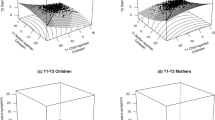Abstract
A framework is proposed for determining the importance of cohesion and communication between families and day care. It is suggested that high cohesion and communication are desirable for parents of infants or families of children with special needs, while decreasing cohesion with continued high communication may be appropriate as children get older.
Similar content being viewed by others
Bibliography
Aldous, J. (1978).Family careers: Developmental changes in families. NY: John Wiley & Sons.
Corwin, R.G., & Wagenaar, T.C. (1976). Boundary interaction between service organizations and their publics: A study of teacher-parent relationships.Social Forces, 55, 471–492.
Cox, P. (1980). Building parent/provider business relationships.Day Care and Early Education, 7, 32–33.
Galinsky, E. (1987).The six stages of parenthood. Reading, MA: Addison-Wesley.
Galinsky, E. (1988). Parents and teacher-caregivers: Sources of tension, sources of support.Young Children, 43, 4–12.
Galinsky, E., & Hooks, W.H. (1977).The new extended family: Day care that works. Boston: Houghton Mifflin Company.
Galvin, K.M., & Brommel, B.J. (1986).Family communication: Cohesion and change (2nd ed.). Glenview, IL: Scott, Foresman and Company.
Hess, R.D., Price, G.G., Dickson, W.P., & Conroy, M. (1981). Different roles for mothers and teachers: Contrasting styles of child care. In S. Kilmer (Ed.),Advances in early education and day care, Vol. 2 (pp. 1–28). Greenwich, CT: JAI Press Inc.
Honig, A.S. (1975).Parent involvement in early childhood education. Washington, DC: National Association for the Education of Young Children.
Hughes, R., Jr. (1985). The informal help-giving of home and center child care providers.Family Relations, 34, 359–366.
Hughes, R., Jr., & Durio, H.F. (1983). Patterns of child care information seeking by families.Family Relations, 32, 203–212.
Joffe, C.E. (1977).Friendly Intruders: Childcare professionals and family life. Los Angeles: University of California Press.
Kontos, S. (1984). Congruence of parent and early childhood staff perceptions of parenting.Parenting Studies, 1, 5–10.
Kontos, S., Raikes, H., & Woods, A. (1983). Early childhood staff attitudes towards their parent clientele.Child Care Quarterly, 12, 45–58.
Kontos, S., & Wells, W. (1986). Attitudes of caregivers and the day care experiences of families.Early Childhood Research Quarterly, 1, 47–67.
Lombana, J.H. (1983). Home-school partnerships: Guidelines and strategies for educators. NY: Grune & Stratton.
Long, F., Peters, D.L., & Garduque, L. (1985). Continuity between home and day care: A model for defining relevant dimensions of child care. In I.E. Sigel (Ed.),Advances in Applied Developmental Psychology: Vol. 1 (pp. 131–170). Norwood, NJ: Ablex Publishing Corporation.
Lortie, D.C. (1975).Schoolteacher: A sociological study. Chicago: The University of Chicago Press.
McGoldrick, M., & Carter, E.A. (1982). The family life cycle. In F. Walsh (Ed.),Normal Family Processes (pp. 167–195). NY: The Guildford Press.
Minuchin, S. (1974).Families and family therapy. Cambridge, MA: Harvard University Press.
National Association for the Education of Young Children. (1986). Position statement on developmentally appropriate practice in early childhood programs serving children from birth through age 8.Young Children, 41, 4–19.
Olson, D.H. (1986). Circumplex model VII: Validation studies and FACES III.Family Process, 25, 337–351.
Olson, D.H., Russell, C.S., & Sprenkle, D.H. (1983). Circumplex model of marital and family system: VI. Theoretical update.Family Process, 22, 69–84.
Powell, D.R. (1978a). Correlates of parent-teacher communication frequency and diversity.Journal of Educational Research, 71, 333–341.
Powell, D.R. (1978b). The interpersonal relationship between parents and care-givers in day care settings.American Journal of Orthopsychiatry, 48, 680–689.
Powell, D.R. (1980). Toward a socioecological perspective of relations between parents and child care program. In S. Kilmer (Ed.),Advances in early education and day care, Vol. 1 (pp. 203–226). Greenwich, CT: JAI Press Inc.
Radin, N. (1972). Three degrees of maternal involvement in a preschool program: Impact on mothers and children.Child Development, 43, 1355–1364.
Riley, D., & Cochran, M.M. (1985). Naturally occurring childbearing advice for fathers: Utilization of the personal social network.Journal of Marriage and the Family, 47, 275–286.
Stevens, J.H., Jr. (1982). The National Day Care Home Study: Family day care in the United States.Young Children, 37, 59–66.
Unger, D.G., & Powell, D.R. (1980). Supporting families under stress: The role of social networks.Family Relations, 29, 566–574.
Walsh, K.K., & Deitchman, R. (1980). Evaluation of early childhood programs: The role of parents.Child Care Quarterly, 9, 289–298.
Wardle, F. (1982). Are parents being left out of their children's early care and education?Day Care and Early Education, 9, 29–31.
Winget, M., Winget, W.G., & Popplewell, J.F. (1982). Including parents in evaluating family day care homes.Child Welfare, 61, 195–205.
Winkelstein, E. (1981). Day care/family interaction and parental satisfaction.Child Care Quarterly, 10, 334–340.
Wolfendale, S. (1983).Special aspects of education: Vol. 3. Parental participation in children's development and education. NY: Gordon and Breach Science Publishers.
Author information
Authors and Affiliations
Additional information
The author wishes to thank Penny L. Deiner, Marion C. Hyson, and Donald L. Peters for their comments on early drafts of this manuscript.
Rights and permissions
About this article
Cite this article
Whitehead, L.C. Cohesion and communication between families and day care: A proposed model. Child Youth Care Forum 17, 255–267 (1988). https://doi.org/10.1007/BF01083906
Issue Date:
DOI: https://doi.org/10.1007/BF01083906




